The weight room at the Bobby Mattick Training Center in Dunedin, Fla., which Toronto Blue Jays minor-leaguers had been using during spring training since the franchise’s inception nearly 35 years ago, was not a spacious one.
Even after a 2002 renovation, the facility fit only about 15-20 players at a time. And that was stretching it. Really, it could accommodate about eight adults comfortably before backlogs began to form at various pieces of equipment. Local high schools had better facilities. Your office gym was more practical.
But in his role as Toronto’s minor-league strength and conditioning coordinator, Steve Rassel’s job is to be creative. To work with the resources he’s given. So, when he was programming workouts for Blue Jays prospects, he didn’t order exercises based on what was optimal from a training perspective; rather, it was based on what wouldn’t create bottlenecks.
He’d ask players to take portable pieces of equipment out of the weight room and into the dressing room to use in front of their lockers. He’d send athletes outside under the hot Florida sun to stretch and warm up on a small, downward-sloping patch of turf just outside the gym.
“Some guys would accidentally slide or roll down the hill as they’re doing their foam rolling prep,” Rassel said. “Everybody would get their stuff in. But it was always inconvenienced and always different than how we initially would have designed it.”
That’s not how a professional sports team ought to be operating in 2021. It’s not how one ought to have been operating in 2011. That’s about when English Premier League clubs such as Tottenham and Chelsea were opening state-of-the-art training grounds; when NCAA programs at Oregon, Alabama, and Texas A&M were overhauling their football complexes.
Over the decade since, 22 MLB teams have undergone major renovations or completely replaced their training facilities. That’s why Blue Jays president Mark Shapiro describes the recently completed renovation of the organization’s player development complex, which club representatives unveiled Thursday, as “skipping a generation.” The Blue Jays are just now catching up to the field.
“It’s something that I’m cognizant of when we talk to players and agents,” Shapiro said. “Dunedin was the laughingstock of MLB, frankly.”
At a total cost (including 2020’s TD Ballpark renovation) of over $100-million USD — jointly funded by the Blue Jays, the city of Dunedin, Pinellas County and the state of Florida — the Blue Jays have upgraded from one of MLB’s poorest facilities to one of its best. It’s the culmination of more than five years of research, design, and construction — a gigantic undertaking by more than 2,500 putting in an estimated 500,000 cumulative worker-hours.
Starting this spring, Rassel will never have to program around Mattick Center’s cramped, out-dated, windowless weight room again. That’s been supplanted by a two-floor, 22,539 square-foot basilica of iron measuring nearly six times the size and outfitted with more than 40,000 pounds of strength equipment.
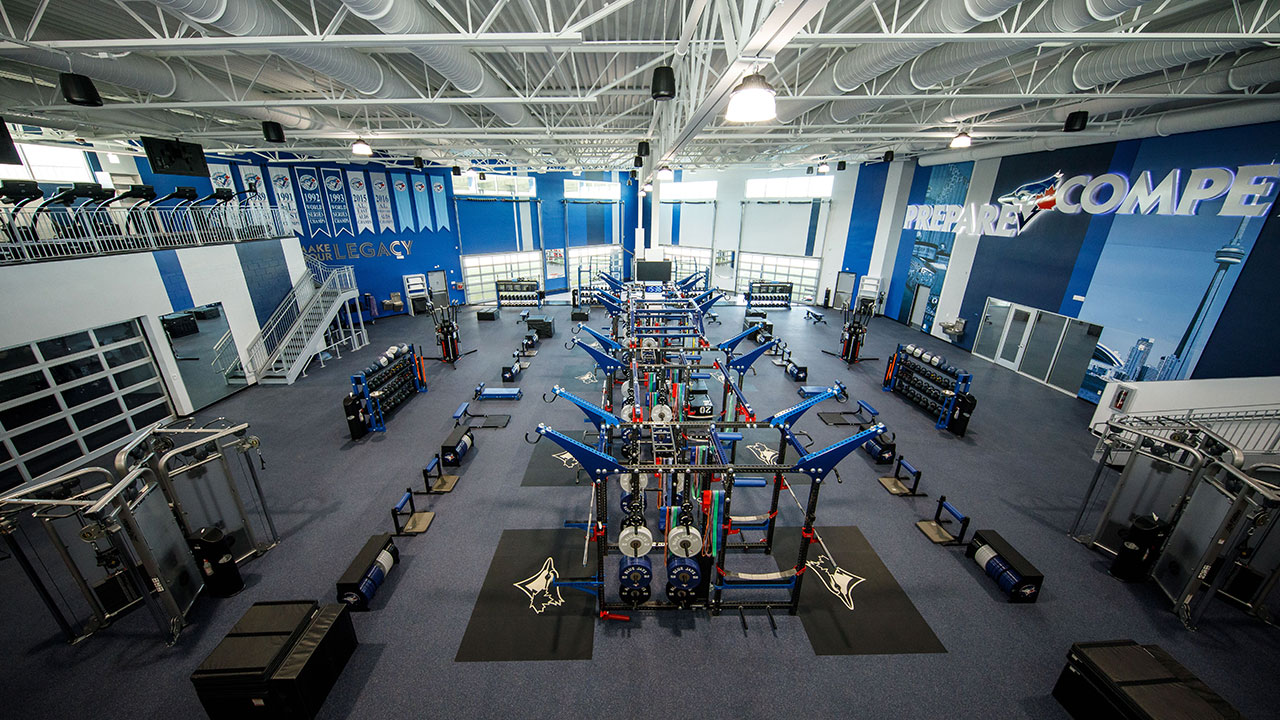
(Credit: Toronto Blue Jays)
The tiny Mattick dressing rooms and their eight-foot ceilings have been abandoned in favour of eight expansive new locker rooms, including a massive, oval-shaped major-league clubhouse with 72 lockers measuring eight-feet tall themselves. A disorganized, 977-square-foot Mattick training room that doubled as office space gives way to multiple new rehabilitation and recovery areas, including a suite of hydrotherapy tubs, accounting for over 5,500-square-feet of space.
You get the picture. Everything is bigger, better, modernized, more functional. The complex now has six full fields, including one with artificial turf and measurements identical to the Rogers Centre, meant to mimic the environment players will encounter in Toronto. There are new bullpens and batting cages; a 168-foot, man-made sprint hill that climbs 20 feet of elevation at a 6.79-degree incline; and covered outdoor training areas, including a full-size turf infield, so work can continue in good weather and bad.
Inside the complex’s central building, dozens of classrooms, meeting rooms and workrooms accommodate groups as large as 130 or as small as two. Close to 3,000-square-feet of sports science labs, a kitchen nearly 10 times the size of Mattick Center’s, separate dining facilities for major- and minor-leaguers, grab-and-go stations stocked with food, beverages and supplements — even a two-chair barber shop.
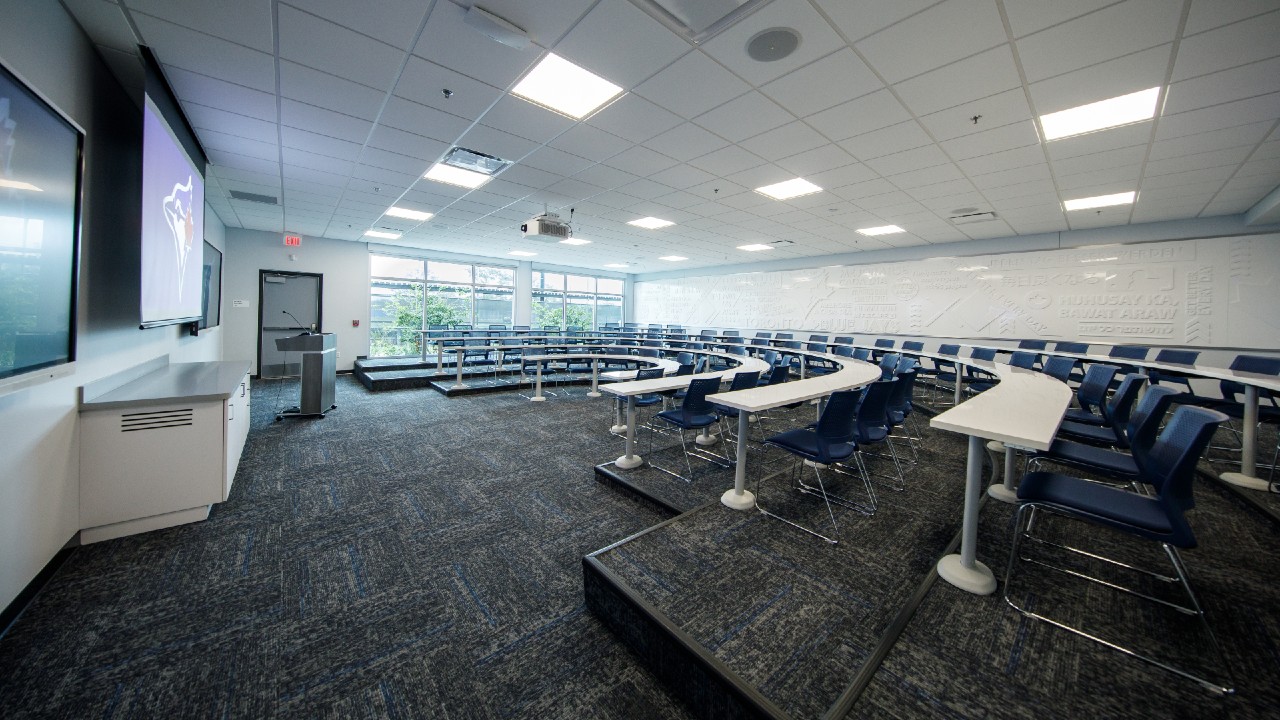
(Credit: Toronto Blue Jays)
“You just have everything here. You have anything you need — anything you could possibly think of,” said Tyler Chatwood, a Blue Jays reliever who signed this off-season. “You're spoiled, essentially. It's all right here and accessible to you.”
That's great for the 75 players in Blue Jays big-league camp currently breaking the place in, but this is hardly just about them. Long ago, the paradigm of club complexes shifted. It’s not a spring training facility meant purely for regular season preparation — it’s a player development factory meant to be utilized year-round.
That means hosting a series of specialized off-season development camps, as the Blue Jays did for nearly 100 players late last year. It means housing off-season training for current major-leaguers, as it did this winter for Bo Bichette, Ryan Borucki, Danny Jansen, Nate Pearson, Jordan Romano and Rowdy Tellez.
Eager-to-improve young athletes such as Bichette, Pearson and Romano have spent prior off-seasons training away from the club at private facilities like Driveline and Kinetic Pro Baseball, which offered more modern resources to help advance their careers. Now, the Blue Jays hope, those players will have everything they need in-house.
“It’s not just about a player getting use out of the facility,” Shapiro said. “It's about, over a multi-year period, creating a place where our minor-league players, our player development staff, our performance staff, and our major-league players all have the desire and financial ability — because of the housing in this area — to want to move and live and train here.”

(Credit: Toronto Blue Jays)
It also means hosting weeks-long orientations for newly drafted players and international signees, running them through intake processes and getting everyone situated within their new organization. It means language lessons for non-English speakers; high-performance strength and nutrition seminars for younger players unfamiliar with professional training modalities; and biomechanical analysis gathered with motion capture sensors and high-speed cameras, identifying movement pattern inefficiencies and opportunities to unlock more velocity and power.
It means fostering smoother transitions from amateur to professional baseball or helping and potentially expediting the recovery process for athletes rehabilitating from injury. Even giving active players who are worn down or under-performing at a minor-league affiliate a one- or two-week breather from that competitive environment to regroup and focus on development before re-entering the minor-league grind with a clearer mind and refreshed approach.
Remember, everything this organization does is developmentally minded and geared towards producing future waves of young talent to either supplement the major-league team or be utilized in trades for more presently impactful players. A modernized complex to house spring training is certainly a strong selling point when recruiting veteran MLB free agents such as George Springer and Marcus Semien. But the players it will influence most greatly aren’t the game’s current stars — it’s the future ones.
“Obviously, it's a competitive advantage to have as many homegrown players as you can impacting your big-league roster,” said Blue Jays director of player development Gil Kim. “And that's something that everybody in our player development group is committed to.”
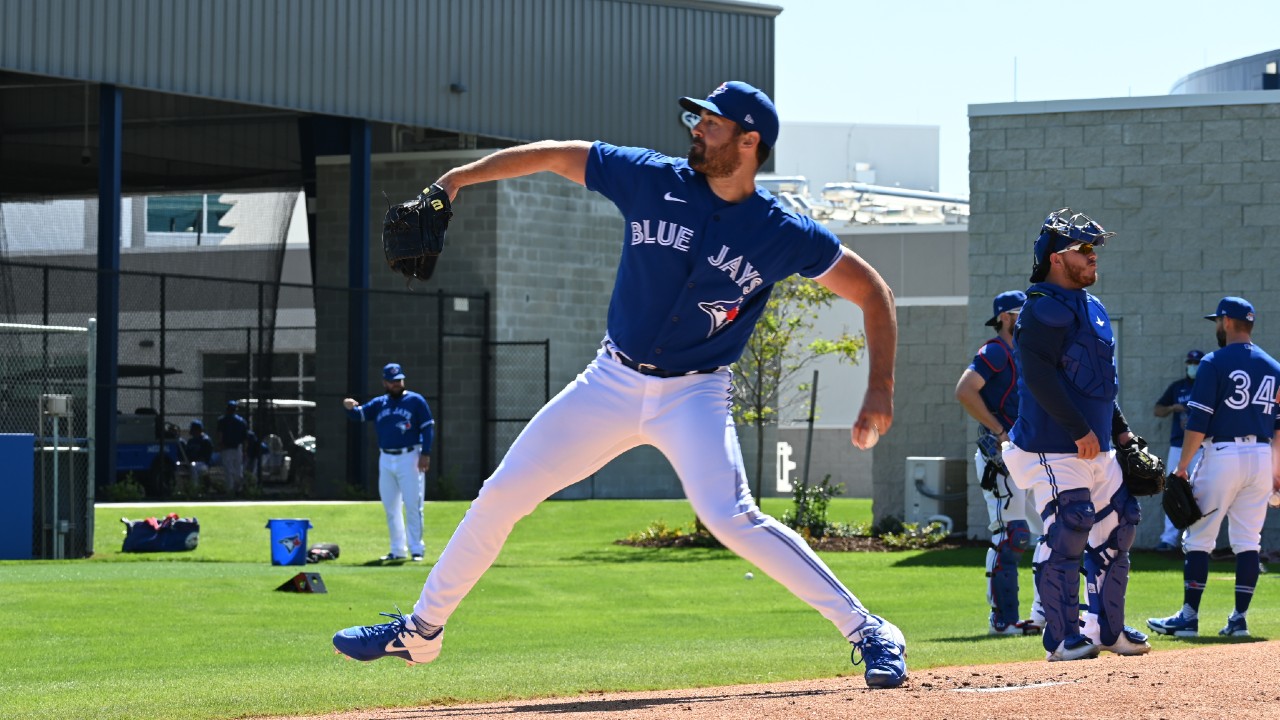
(Credit: Toronto Blue Jays)
The bedrock of MLB’s most successful organizations isn’t signing players like Springer in their 30s when they’re already well into their primes — it’s producing players of his calibre from within. How did Springer’s Houston Astros build an absurdly stacked young core that carried the team to four consecutive ALCS appearances? By investing heavily in data-driven player development at a time when their competitors had yet to clue in, igniting the developmental arms race that’s played out industry-wide since.
Why have the Los Angeles Dodgers been one of MLB’s most perennially successful clubs for over a decade? Running payrolls in excess of $200-million USD certainly helps. But so, too, does having a current 40-man roster with 22 homegrown players on it, including core pieces like Cody Bellinger, Corey Seager, Walker Buehler and Kenley Jansen, not to mention the various others used in trades to acquire supplemental premier talent such as Mookie Betts.
Using prospects as currency is how the San Diego Padres have built their juggernaut to try to take down those Dodgers, having traded for 12 of 19 roster players currently on guaranteed MLB deals and more than half of their 40-man roster. But it speaks to the underlying, regenerative strength of San Diego’s player development process that, in spite of all those moves, the club’s minor-league system is still widely considered one of the 10 best in the game.
No club’s system is as stacked as the Tampa Bay Rays, an organization that routinely runs one of MLB’s lowest payrolls yet has finished the season with a .556 winning percentage (a 90-win pace) or higher in eight of the last 13 seasons. Developing a steady stream of quality big-leaguers, reaping the surplus value of their low-cost, early-career production, trading those players once their earning power increases as they approach free agency, and systematically replacing them with more young, inexpensive, homegrown talent has been the developmental motor driving all that cost-controlled success.
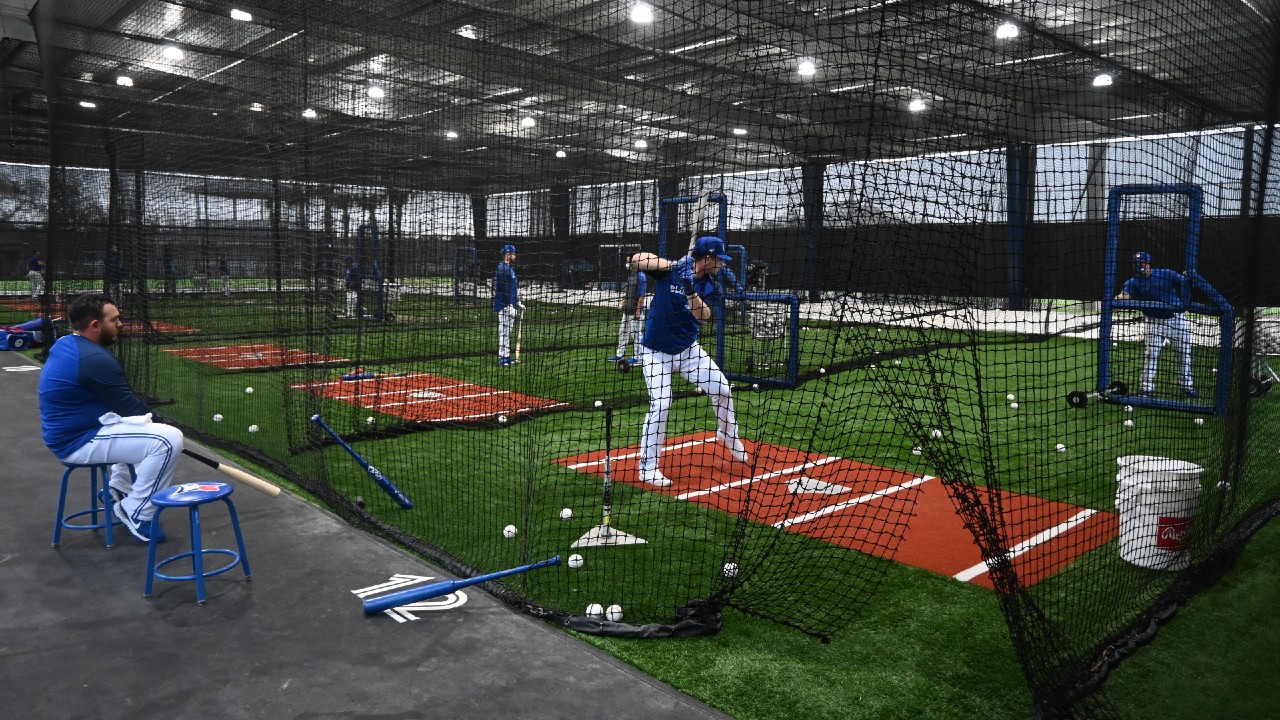
(Credit: Toronto Blue Jays)
Some of the first Blue Jays to make use of the team’s new facilities were actually minor-leaguers who passed through this winter as part of that series of specialized training camps intended to help make up for lost developmental time in 2020. Adam Kloffenstein, a 20-year-old right-hander the Blue Jays selected in the third round of the 2018 draft, was among them, spending two weeks at the complex in November diving into the data on his two-seam fastball in the pitching lab, throwing on the covered turf infield and grinding out workouts in the sprawling weight room.
Kloffenstein is in the big-league camp this year, but he was on the minor-league side each of the last two springs, which meant he grew all too familiar with the cramped, inadequate spaces the organization’s youngest players were doing their best to make gains in prior to the renovation.
“It was just a wreck — especially during spring training when you’ve got dozens of guys in there,” Kloffenstein said. “Now, nobody’s in your way. Nobody’s using something that you need to use. You can tell there wasn’t any expense spared.”
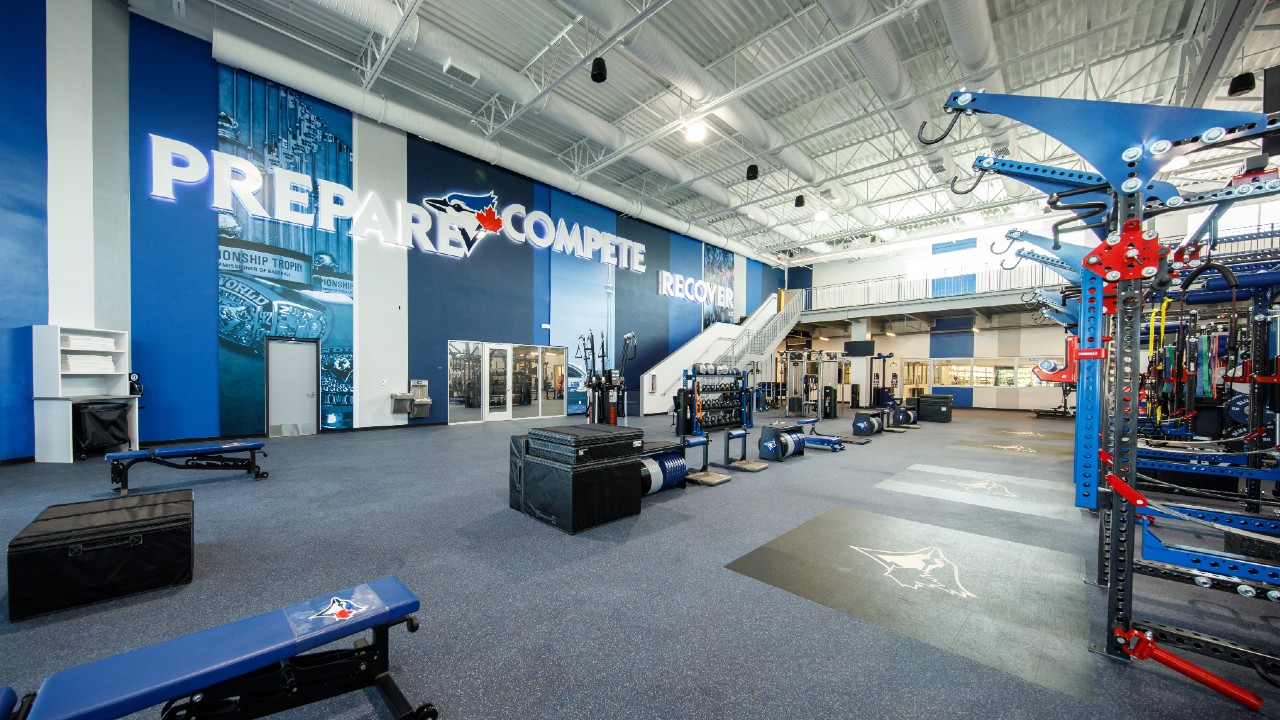
(Credit: Toronto Blue Jays)
Going forward, it’s players like Kloffenstein, a high school draftee who began his professional career at 17 in the unforgiving grind of the Gulf Coast League, who stand to benefit the most from the new facility — particularly considering there’s no more Gulf Coast League for players like him to report to.
MLB has spent the last year dramatically overhauling the structure of minor-league baseball, culling entire leagues of teams while limiting each major-league club to four affiliates and 180 total domestic minor-leaguers. For the Blue Jays, that meant losing three affiliates (the Lansing Lugnuts, Bluefield Blue Jays and Gulf Coast League Blue Jays), dozens of athletes, and several coaches and coordinators from the organization.
It’s important to state here that a condensed minor-league system means fewer jobs and less opportunity for individuals to make a living in the game. There’s no positive to be found in that unless you’re an accountant for an MLB team. And from a fan perspective, less professional baseball is unquestionably a bad thing — particularly for those in the small towns across the continent that are no longer home to minor-league affiliates.
But under the old system, MLB front offices saw their resources being spread too thin. From a cold, calculated business perspective, the operational cost of a distant rookie-ball affiliate wasn’t worth the potential return of discovering the next Kevin Pillar, a late-round draft pick who, against significant odds, fights his way up the minor-league ladder to become an MLB regular.
Rather, organizations believe they can do a much more effective — and, cynically, cost-efficient — job of producing future Pillar’s with a more streamlined, centralized developmental operation, like what the Blue Jays envision running at their new complex. Rather than sending a recent amateur draftee to tiny Bluefield, where the rookie-ball Blue Jays were operating out of a charming yet antiquated facility, the club will transition those players to the professional ranks in Dunedin. They’ll have access to far greater resources and, in turn, a greater chance of making strong developmental strides.
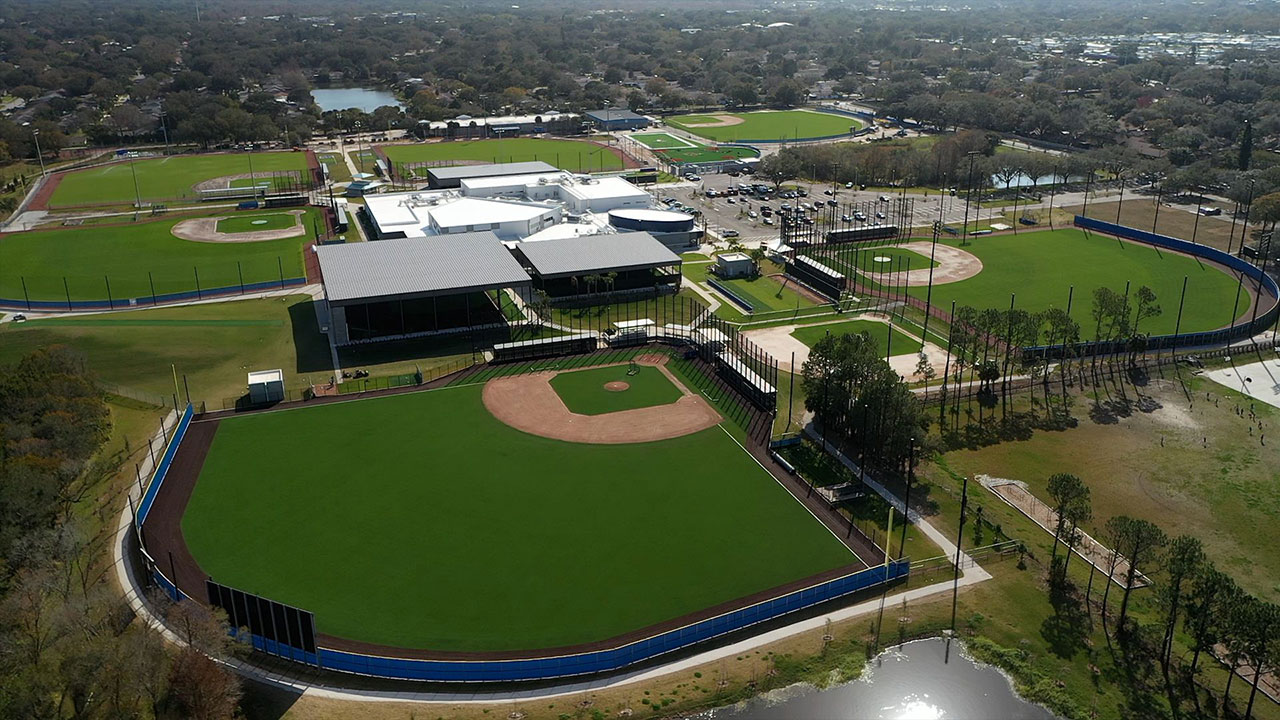
(Credit: Toronto Blue Jays)
Outside of its four affiliates, every major-league organization will be able to operate a rookie-level team out of its spring training complex in an academy-style system, playing unofficial games against other organizations in the area. That’s where teenaged high school draftees will get their first taste of professional competition before advancing to Toronto’s lowest-level minor-league affiliate, conveniently located right there in Dunedin.
Rather than grinding out eight-hour bus rides between distant minor-league towns, subsisting on dollar value menu items, and trying to make substantial athletic improvements without access to modern player tracking technology or adequate recovery facilities, the organization’s youngest prospects could feasibly spend the first couple years of their professional lives based out of the player development complex, with access to every resource they need to fulfill their potential.
They’d also glean the benefits of rubbing shoulders with current big-leaguers during spring training, learning by observing the daily routines and approaches of the game’s best players who occupy the 3,750-square-foot major-league clubhouse they hope to one day have their own stall in.
“I like how it's intertwined with the minor-league side,” Chatwood said. “So that [minor-leaguers] see you going about your business the right way. You try to show what it takes to be a big-leaguer.”
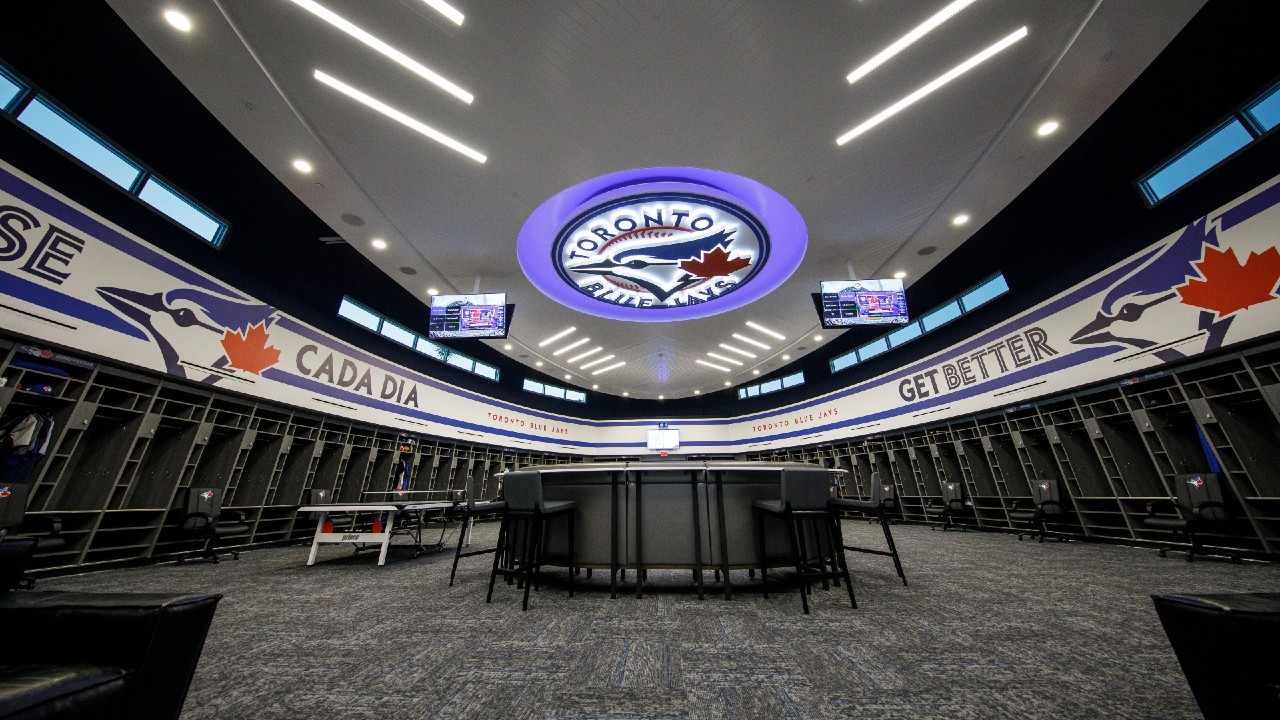
(Credit: Toronto Blue Jays)
More advanced college draftees stand to benefit, as well. Take 2020 first-round pick Austin Martin. He spent his last three years at Vanderbilt University, where Commodores players have access to 30,000-square-feet of modern training and rehab facilities that underwent a $12-million renovation in 2018.
Martin’s accustomed to working out in a vast weight room with every piece of equipment he can imagine and recovering in hydrotherapy tubs similar to the ones the Blue Jays just installed. If he was drafted by Toronto two years ago, likely beginning his minor-league career with Dunedin, his introduction to a professional environment would’ve represented a significant downgrade from what he’d experienced as a student-athlete.
Developmentally, there’s nothing worse. Trying to acclimatize to a higher level of competition without the resources you’ve been relying on for years isn’t a recipe for success. It’d be like taking a high schooler with an interest in programming and dropping them into a computer science college course while switching out their present-day laptop for a '90s era desktop.
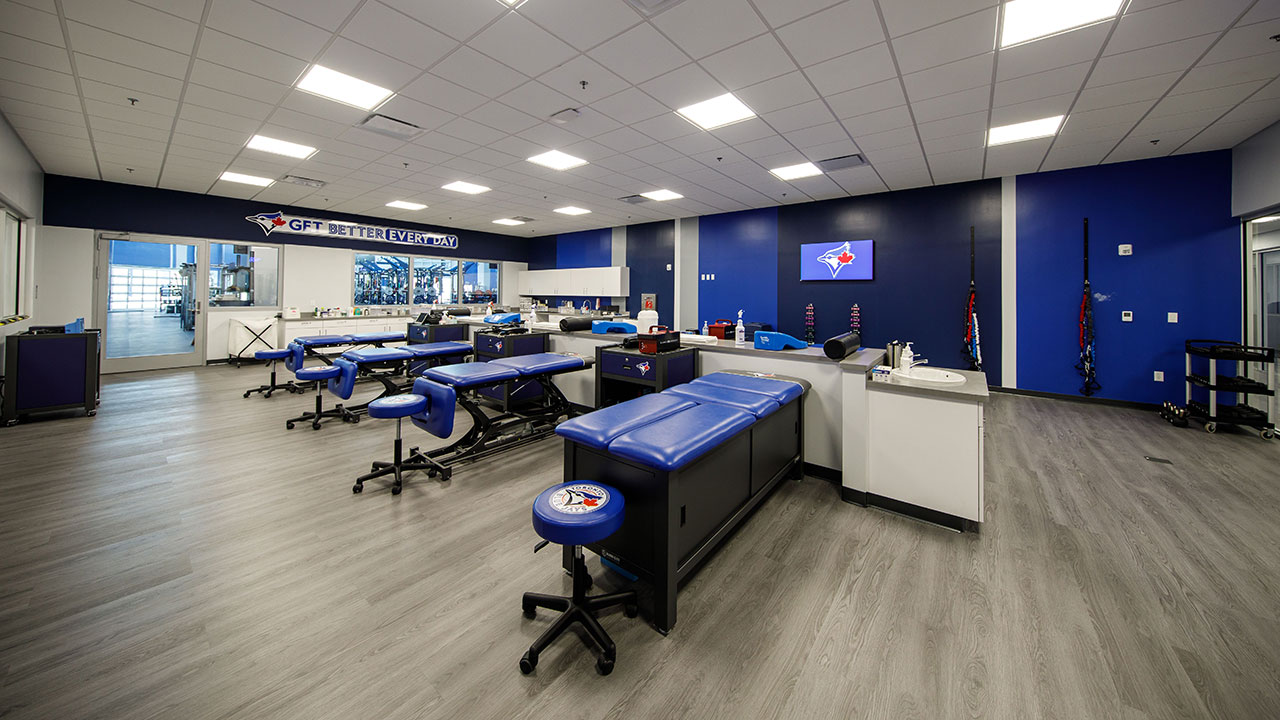
(Credit: Toronto Blue Jays)
In a funny way, pandemic baseball served to push some of these evolutions along. In 2020, every club established an alternate training site where players on the edge of the major-league roster focused on development and finding ways to improve outside of in-game competition. Clubs devised creative methods to simulate game-like environments and recreate the pressure of high-leverage baseball. Intrasquad games are an obvious means, but the Blue Jays also utilized high-velocity pitching machines to make batting practice more challenging and turned routine fielding drills into mini competitions between players. Coaches and coordinators will apply those same approaches with young athletes at the complex going forward.
"A lot of what we learned in Rochester was that we could optimize space a lot better than we ever thought. And we can also optimize player improvement and preparation without as many games as we thought,” Kim said. “So, when you bring it back to a place like this that has a lot of space, a lot of facilities and a lot of equipment — I don't want to say it's easier, but it certainly is a lot smoother to plan and program for individuals."
The Blue Jays produced some real success stories out of that alternate site in Rochester, NY., with 22-year-old cannonball catcher Alejandro Kirk being the most prominent one. He hadn’t played a game above high-A coming into the season but made such great developmental strides in Rochester that he earned his major-league debut in September. With only 151 low-level minor-league games under his belt, Kirk went 9-for-24 with three extra-base hits against the best pitchers in the world, drawing rave reviews of his defensive work from veteran starters who likely hadn’t heard of the 2016 international signee weeks prior to pitching to him.
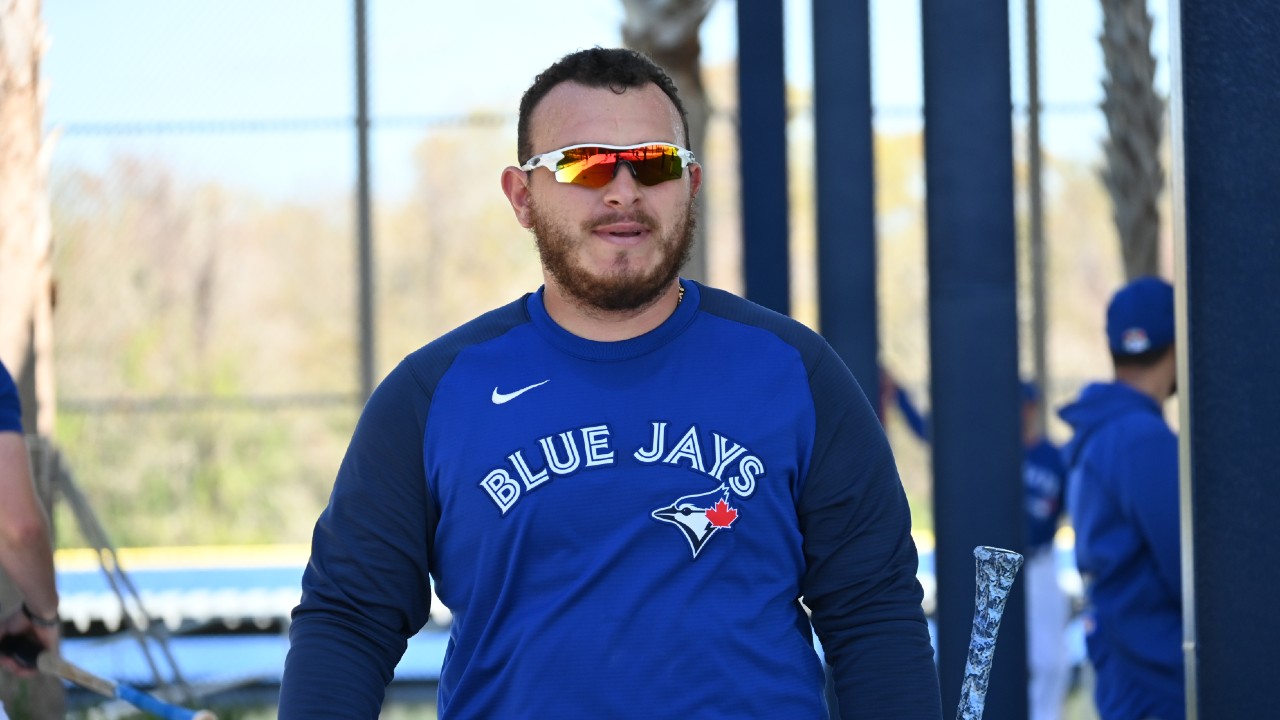
(Credit: Toronto Blue Jays)
But sinkerball specialist T.J. Zeuch is perhaps a better demonstration of what’s possible. The 2016 first-round pick started his 2020 pitching with puzzlingly diminished velocity and getting shelled by minor-leaguers during spring training. And his struggles continued when he reported to summer camp in July after a several-month layoff, ruling out the possibility of injury or fatigue. The problem was he’d lost his mechanics. He’d begun relying too much on his shoulder to produce power rather than sitting back and driving towards the plate, utilizing the much stronger muscles in his legs to generate the velocity he needs to make his downward-plane two-seamer most effective.
Using high-speed video gathered during bullpens thrown in Rochester, Blue Jays developers showed Zeuch how to make the needed adjustments to regain his form. They used Rapsodo data to optimize his arm slot and demonstrate how his slider and cutter played best off his sinker. He was also put on a focused strength and conditioning program designed to help him increase his arm strength and help improve his velocity. Sure enough, within six weeks at the alternate site he went from throwing 87 m.p.h. to touching 93-94 m.p.h. That earned him a late-season call-up and he finished his year in the majors pitching a 1.59 ERA over 11.1 innings, including back-to-back appearances against an imposing New York Yankees lineup.
“Having an experience like that [at the alternate site] is kind of invaluable — where you can work on certain things and you don’t have to worry about your numbers. You don’t have to worry about putting your team in a bad spot because you got knocked around while you were trying to work on a certain pitch,” Zeuch said. “Just being able to go out and throw in these simulated games and work on one or two specific things is really a valuable time.”

(Credit: Toronto Blue Jays)
And it’s really a perfect time to be opening a state-of-the-art facility to nurture player development like that. However you feel about it, MLB is clearly shifting away from its traditional, scattered, affiliate-based development structure to a more centralized, academy-style approach operating out of high-performance complexes like the one Toronto’s just opened. Clubs want more control, more collaboration and more fluid opportunities for young players to access and utilize modern resources. And considering the advanced high school and college programs those athletes are emerging from, they’re expecting it themselves.
Developmentally, Toronto spent a generation being repeatedly lapped by its competitors, watching other MLB organizations find new and innovative ways to produce homegrown talent while Blue Jays prospects were training at their lockers and sliding down hills atop foam rollers. Finally, the club’s caught up to the field. And going forward, the plan is to start leading the race.
“We think it's such an opportunity to bring us all together under one roof to provide the best possible environment for our players to reach their potential — mentally, physically and fundamentally,” Shapiro said. “And, more than anything, we think this building will not just be a foundational block, but a driver in our effort to win world championships. And to be in a position to build a sustainable championship organization.”
